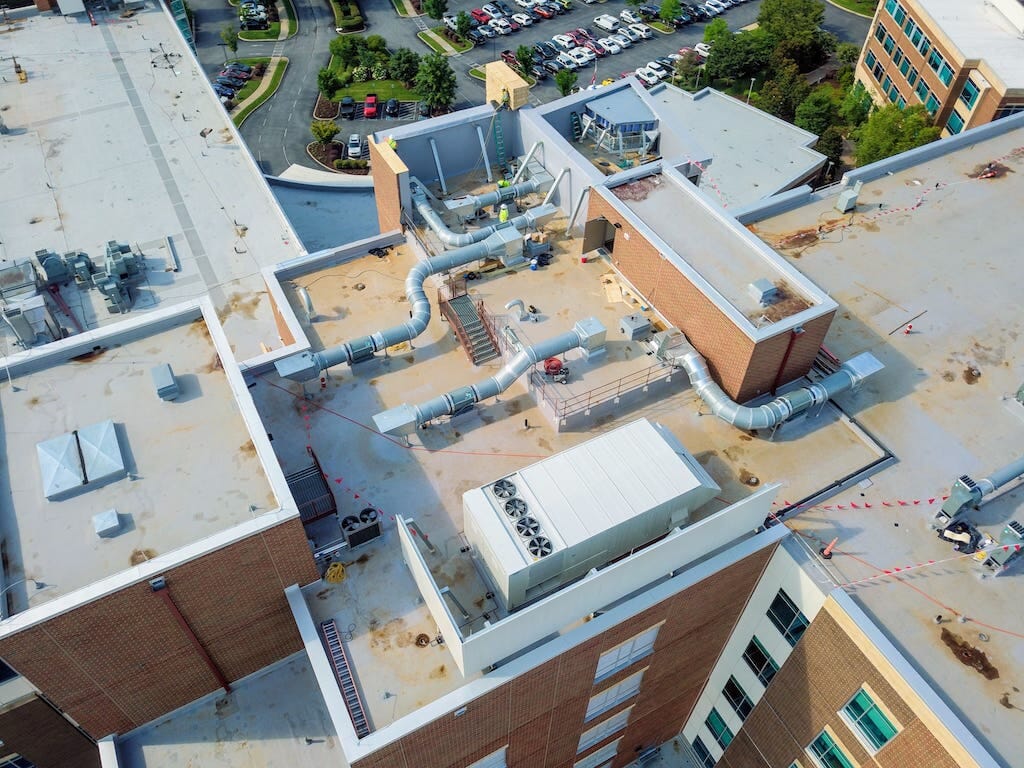No one wants a hole in their building’s roof, but every general contractor understands that rooftop penetrations are sometimes essential for the functioning of a commercial building. From HVAC systems and skylights to vent pipes and solar panels, these penetrations play a critical role—but they also pose unique challenges. Poorly executed penetrations can compromise a roof’s integrity, leading to leaks, and costly repairs.
Roofing contractors regularly handle rooftop penetrations during commercial construction projects. For general contractors and construction managers operating under tight timelines and budgets, it’s important to collaborate with an experienced roofing contractor to ensure that these penetrations are executed correctly the first time. We’ve created this guide to help general contractors understand the details of rooftop penetrations to ensure every aspect of your project is a success.
What Is a Rooftop Penetration?
A rooftop penetration is any opening made in the roofing membrane and roof deck to accommodate equipment or infrastructure. Here are just a few types of intentional roof penetrations:
- Skylights—Skylights can dramatically improve the natural light in your building without taking up valuable wall space.
- Solar Panels—Large solar units for a commercial building at times are fastened to the roof deck, which puts small holes into the roof.
- Pipes and Drains—Some complex pipe systems may be kept on a building’s roof and need entry into the building.
- HVAC Systems—Large commercial heating and cooling units are often kept on a building’s roof, and penetration will be needed to bring warm or cool air inside the building.
- Exhaust Fans—Exhaust fans can help remove steam, odors, or other unwanted pollutants in your building’s air.
- Vents—Vents suck out moisture or pump air to provide ventilation to a building.
Almost every commercial roof will require some type of penetration for the building to function properly. While necessary, penetrations are one of the most complex elements of commercial roofing construction, and these areas are the most vulnerable parts of a completed roof.
Best Practices for Installing Roof Penetrations
Penetrations are best installed during initial construction. Whenever possible, plan rooftop penetrations during the design and construction phases to integrate them seamlessly with the roofing system.
It’s also important to work with a professional roofer during this process. Penetrations are complicated, requiring unique detail flashings depending on the roof type that few other construction contractors are trained to use. Improper installation can result in a leak at the penetration, which can be a costly repair down the road. While HVAC contractors or skylight installers may offer penetration services, only a specialized roofer has the expertise to maintain the roof’s integrity and comply with manufacturer details and industry standards.
Not everything about a commercial building can be planned right from the outset. If you wind up needing a roof penetration down the road, your roof can be retrofitted, but it may be a more complex process. Penetrating a roof that’s already constructed requires puncturing your “building envelope,” which refers to the materials that seal a building off from the elements. After installing a roof penetration, this envelope needs to be properly re-sealed to protect the building. Adding a penetration changes the original design of the roof system, which can affect drainage.
Maintaining a Roof Penetration
General contractors should be aware that a roof with penetrations will require more regular maintenance than one without. Flashing, sealant, and other elements of penetrations should be monitored to keep the roof waterproof. Be sure to develop a plan with your commercial roofer for how to protect roofing penetrations and keep personnel away from them.
A reputable commercial roofing company should be able to design, build, and maintain the penetrations. At Maxwell Roofing & Sheet Metal, Inc., we understand the complexities of rooftop penetrations and our team of experts has the experience to walk you through the process, from design to installation and continued maintenance.
Whether you’re managing new construction or retrofitting an existing building, Maxwell Roofing provides the expertise you need to get the job done right. Contact us today about your next project.

